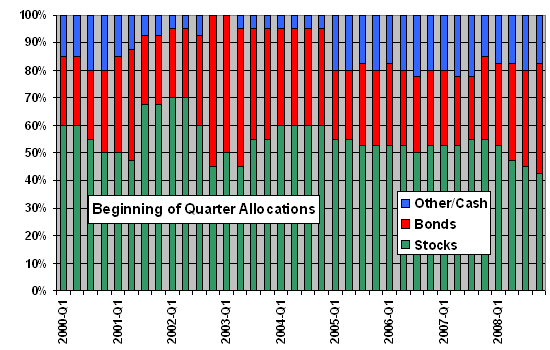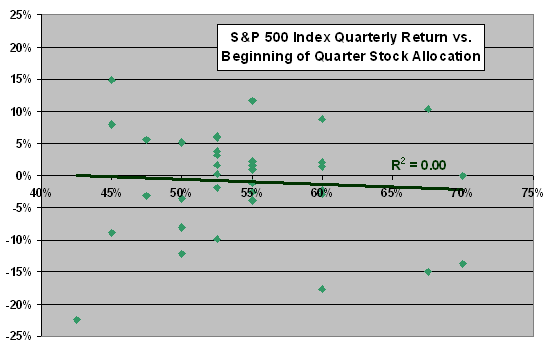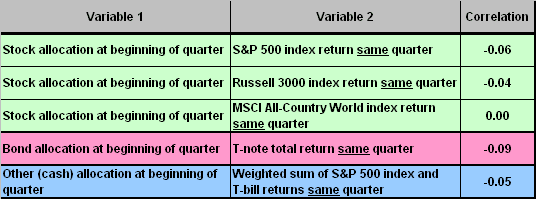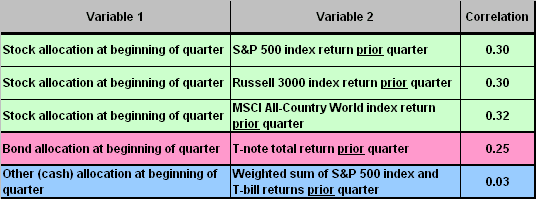A reader requested: “Would you add Tom Madell’s Mutual Fund Research Newsletter to Guru Grades?” The most consistent thread in the Mutual Fund Research Newsletter archive for 2000-2008 [no longer publicly available] is the quarterly asset class allocation (stocks, bonds, cash) recommendation. Variation in recommended allocations across nine years supports a rough assessment of general market timing value. This assessment is related to, but more quantitative than, the narrative forecast reviews for other experts at Guru Grades. Because of this difference, we are not including Tom Madell in the list of experts at Guru Grades. Using the 36 Mutual Fund Research Newsletter quarterly asset class allocation recommendations, along with contemporaneous quarterly returns for proxy assets, we conclude that:
The assumptions we make in performing this assessment are:
- We use S&P 500 index quarterly returns as the principal measure of the performance of stocks each quarter. Because the Mutual Fund Research Newsletter recommends domestic, international and small capitalization funds, we also consider the quarterly returns of the Russell 3000 index and the MSCI All-Country World index.
- We use 10-year Treasury note (T-note) total quarterly returns as the measure of the performance of bonds each quarter. We assume that, on average, this return consists of one fourth the nominal yield at the beginning of the quarter plus a capital gain/loss derived from the change in yield during the quarter.
- We use the average of the 3-month Treasury bill (T-bill) yield at the beginning and end of a quarter as the measure of the performance of cash that quarter.
- For each quarter and each asset, we use the close at the end of the prior quarter as the beginning value and the close at the end of the current quarter as the ending value.
- Based on the comparative/relative nature of the assessment, we ignore trading frictions.
- We use the middle-of-the-road Mutual Fund Research Newsletter asset class allocation recommendations “For Most Investors” or “For Moderate Risk Investors.”
- In a few cases, a specific newsletter cites prior asset class allocations that differ from those in original beginning-of-quarter newsletter. We always use the values in the beginning-of-quarter newsletters.
- In a few cases, the “Other” asset class includes a real estate investment trust fund as well as cash. Since “Other” is usually cash, we treat this allocation as always cash.
The following chart summarizes the variation in Mutual Fund Research Newsletter quarterly asset class allocation recommendations over the entire 2000-2008 sample period. The average allocation to stocks-bonds-cash across the entire sample period is 54.8%-32.0%-13.2%.
As a first test of the timing value of these shifting allocations, we relate asset class allocation percentages to same-quarter asset class returns. If the changes in allocations have timing value, there should be a significant positive correlation between the quarterly allocations and quarterly returns for each class. In other words, the allocations for a class should be relatively high (low) for quarters during which the returns for the class are high (low).

The following scatter plot relates the quarterly return on the S&P 500 index to the Mutual Fund Research Newsletter stocks allocation percentage at the beginning of the quarter for all 36 quarters. The Pearson correlation for the two series is -0.06, and the R-squared statistic is 0.00. These results indicate no relationship between quarterly allocations to stocks and quarterly stock returns. In other words, variations in the recommended allocation to stocks have no market timing value.
We next repeat this kind of analysis for other measures of the performance of stocks and for a measure of the performance of bonds.

The following table summarizes correlations between Mutual Fund Research Newsletter quarterly asset allocation percentages and same-quarter asset class returns for stocks (three measures of returns) and bonds (one measure of bond returns). It also includes the correlation between cash allocations and returns for non-cash to see whether the model allocation goes to cash when returns are not available elsewhere. In all cases, the correlations are near zero, indicating no market timing value.
What might drive the changes in asset class allocations?

The next table summarizes correlations between Mutual Fund Research Newsletter quarterly asset class allocation percentages and prior-quarter asset class returns. For stocks and bonds the correlations are noticeably positive, indicating that allocations for these classes tend to be relatively high (low) when returns for the previous quarter are high (low). In other words, changes in recommended allocations appear to be somewhat reactive.

As a separate test of the timing value of the Mutual Fund Research Newsletter quarterly asset class allocation recommendations, we compare compare average aggregate quarterly returns for recommendations applied to the S&P 500 index, T-notes and T-bills to average aggregate quarterly returns for a constant 60-30-10 stocks-bonds-cash allocation across the entire sample period. Results are as follows:
Using the S&P 500 index to represent stocks, the Mutual Fund Research Newsletter quarterly asset class (constant 60-30-10) allocations generate an average quarterly return of 0.16% (0.20%), with quarterly standard deviation of 4.04% (4.12%).
Using the Russell 3000 index to represent stocks, the Mutual Fund Research Newsletter quarterly asset class (constant 60-30-10) allocations generate an average quarterly return of 0.28% (0.32%), with quarterly standard deviation of 4.21% (4.31%).
Using the MSCI All-Country World index to represent stocks, the Mutual Fund Research Newsletter quarterly asset class (constant 60-30-10) allocations generate an average quarterly return of 0.36% (0.37%), with quarterly standard deviation of 4.36% (4.63%).
The constant 60-30-10 asset class allocation generates slightly higher average quarterly returns than do the changing Mutual Fund Research Newsletter quarterly asset class allocations, but with slightly more variable returns.
As an aside, the average quarterly returns during 2000-2008 for the three stock indexes used above are all negative (with the S&P 500 index the worst). In contrast, the average quarterly return for T-notes is about 2.4%.
In summary, …
This review does not evaluate the performance of the hundreds of specific fund recommendations offered in the 36 newsletters that recommend asset class allocations.
Tom Madell, Publisher of the Mutual Fund Research Newsletter, sent the following four comments on the above review:
Comment 1: “…our Model Portfolios were never designed, nor do they have any value if you are expecting to get improved results every quarter. Rather, our Models are predicated on the attempt to improve results over at least the following year or two, and continuing up to five years later.”
Response 1: Mutual Fund Research Newsletter changes its recommended asset class allocations every quarter. It is not logical to relate the recommended asset class allocation for a given quarter to returns one to five years in the future, because an investor following the advice of the newsletter implements the allocation for a given quarter only during the ensuing quarter. During the future quarters over the next one to five years, the investor would implement the allocations recommended for those future quarters. In other words, the recommended allocation for a specific quarter is not in effect during quarters one to five years later.
To reiterate the conclusion of the research, an investor who diligently implemented the quarterly asset class allocations across the nine-year history in the Mutual Fund Research Newsletter archive would not have accrued any significant market timing benefit. In fact, the analysis finds that, over the entire 2000-2008 sample period using three very different equity indexes, a constant 60-30-10 stocks-bonds-cash allocation generates a higher average raw return than does the series of variable quarterly allocations recommended by the newsletter.
Comment 2: “[The analysis] did not address our primary purpose which is to help an investor in making fund selections and portfolio rebalancing by recommending those categories within the stock market as well as within the bond market that appear to have the best prospects for relatively better performance.”
Response 2: As clearly stated in the review, the analysis measures only the market timing value of the quarterly asset class allocations recommended by the Mutual Fund Research Newsletter. Moreover, the analysis explicitly states that it does not address the value of fund-picking. Rigorous assessment of fund-picking value would entail construction and benchmarking of hundreds of separate returns.
Comment 3: “…it would be interesting to see if [the] analysis of our overall quarterly stock, bond, and cash positions could show whether they might predict where the stock and bond indices might be a year or more after making them.”
Response 3: Such an analysis would not be relevant to the experience of an investor actually using the quarterly asset class allocations recommended by the Mutual Fund Research Newsletter. As noted above, a year or more after a specific allocation recommendation, the investor would be using some new recommended allocation and not one made in the past. Posed plainly, why would an investor care about the correlation between current returns and an allocation recommendation from two years ago when the investor stopped using that allocation seven quarters ago?
Comment 4: “But even if such an analysis does not show particularly promising results, it cannot negate the history of positive findings we have already shown in terms of improved performance over the S&P 500 Index when one measures how one’s stock portfolio would have outperformed vs. the Index.”
Response 4: As clearly stated in the review, the analysis measures only the market timing value of the quarterly asset class allocations recommended by the Mutual Fund Research Newsletter.
The analysis does note that “the Mutual Fund Research Newsletter recommends domestic, international and small capitalization funds.” The use of the S&P 500 index as a benchmark for the newsletter’s equity fund recommendations may therefore not be in alignment with the mutual fund industry practice of benchmarking performance against an index covering a similar universe of stocks. Some index constructed from a universe of stocks much larger than the S&P 500 may be appropriate for benchmarking the newsletter.